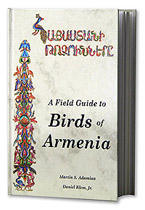- Pictures of All Birds
- Find Bird by Common Name
- Find Bird by Scientific Name
- Find Bird by Armenian Name
- Orders of Birds
- Distribution Maps
- Location of Armenia
- Species of Special Concern

Purchase the Field Guide
© Copyright Birds
of Armenia Project

| Armenian Name: | Մեծ ձկնկուլ |
|---|---|
| Species Status: | Threatened Species - Species of Special Concern |

See Plate 2 for Great Cormorant and other similar species
| Resident Status: | Year-round resident |
|---|---|
| Abundance: | Uncommon |
| Length: | 80-100 cm, Wing Span:130-160 cm |
| Distribution Map: | Map 8. |
| Adult (Breeding): | Mostly white head and white oval patches on thighs. Body black with green gloss on upperparts. |
| Adult (Non-breeding): | Lacks green gloss and white on head and thighs. |
| Juvenile: | Black-brown above with off-white underparts. Neck band is variable in size. |
| Similar Species: | Differs from Pygmy Cormorant by blacker plumage and body that is about twice its size. |
| Behavior: | Often perches on rocks or trees with outstretched wings. Flocks fly in V-formation or in straight or bowed lines. Flies with neck extended and slightly kinked. |
| Habitat: | Lakes, marshes, rivers, and fish ponds with emergent vegetation. Concentrations of resting birds occur on lake shores. |
| Food: | Fish. |
| Nest: | Colonial; conical piles of reeds in emergent vegetation. |
| Eggs: | 66 mm, 3-4, pale blue or green. |